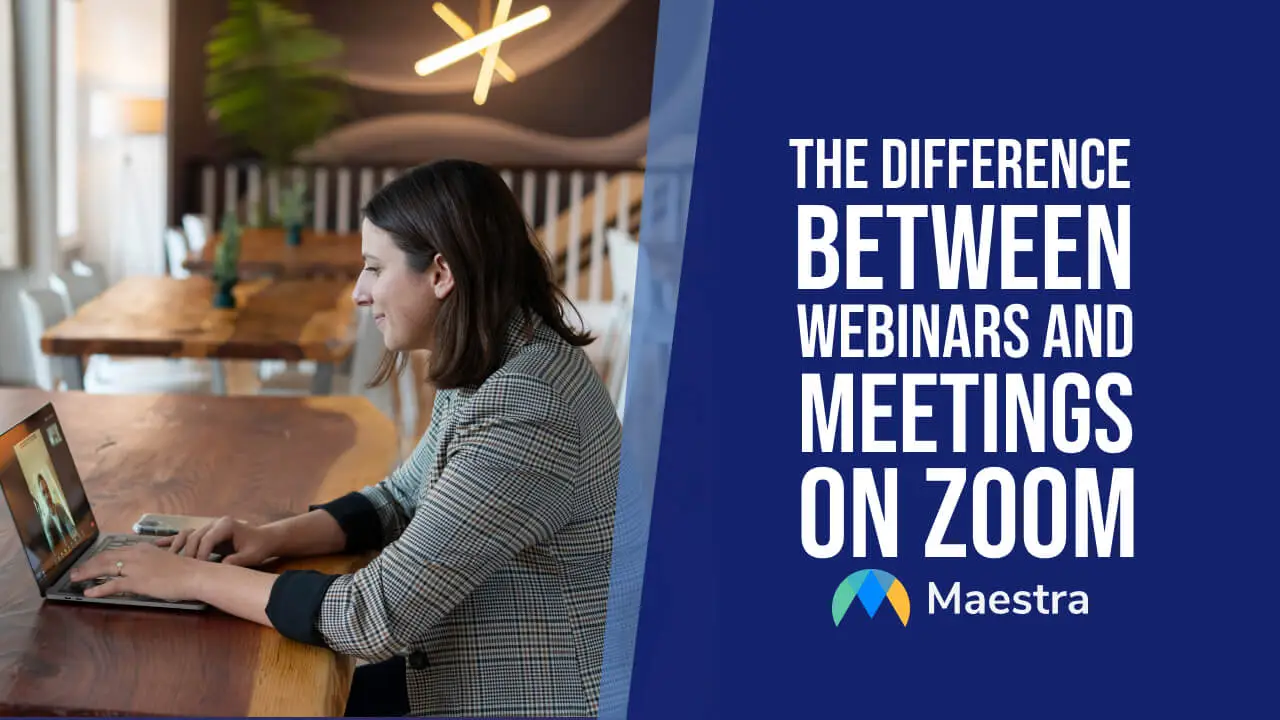The Difference Between Webinars and Meetings on Zoom

With remote work and virtual events here to stay, understanding the difference between Zoom Meetings and Zoom Webinars is essential. Each format has unique strengths, and choosing the right one can be the difference between a successful interactive experience and a streamlined presentation. In this guide, we’ll look closely at the strengths, differences, and best use cases for each format, so you can make an informed choice for your next event.
Key Difference Between Zoom Meetings and Webinars
A Zoom Meeting is an interactive format, allowing all participants to engage with audio, video, and screen-sharing, making it ideal for small groups, team collaboration, and discussions. Zoom Webinars, in contrast, are presentation-driven events where only the host and panelists can speak and share video, creating a more controlled environment suited for lectures, large-scale presentations, and one-to-many communication.
In short, choose Zoom Meetings for active collaboration and Zoom Webinars for structured presentations to large audiences.
| Feature | 🤝Zoom Meeting | 📚Zoom Webinar |
|---|---|---|
| Purpose | Collaborative discussions and team meetings | Presentation-driven events for large audiences |
| Audience Interaction | All participants can share audio, video, and screen | Only host and panelists can share; limited interaction for attendees |
| Best For | Small to mid-sized groups, brainstorming, workshops | Webinars, lectures, product demos, public events |
| Capacity | Up to 100 (can increase with subscriptions) | From 100 to 10,000, based on plan |
| Key Features | Breakout rooms, collaborative tools, open Q&A | Registration, controlled Q&A, polls, analytics |
Transcribe Zoom Meetings with AI
Zoom Meetings: For Collaborative and Interactive Experiences

Zoom Meetings are built for real-time interaction, making them the go-to choice for team meetings, interactive classes, and small group discussions. If your goal is collaboration, such as brainstorming sessions or workshops, Zoom Meetings offer an ideal platform.
What Sets Zoom Meetings Apart?
Zoom Meetings allow everyone to engage on an equal footing. Each participant has control over their own audio, video, and screen-sharing, making it easier for groups to exchange ideas freely. This feature is especially valuable for projects that require close teamwork or regular group check-ins.
One of the standout features of Zoom Meetings is breakout rooms. For training sessions or workshops, breakout rooms allow you to split participants into smaller groups for focused discussion or activities, which makes it easier to personalize the experience for each attendee.
Zoom Meetings are all about keeping the conversation flowing. The chat and Q&A features allow attendees to ask questions, share links, and respond in real-time, which fosters an environment of open communication. This type of interaction isn’t just a bonus – it’s fundamental to how Zoom Meetings are structured.
The meeting format is perfect for dynamic, informal settings where active participation is key. Hosts can easily assign co-host roles, mute or unmute attendees, and even conduct live polls to make the experience interactive.
Zoom Webinars: For Presentation-Driven Events with Large Audiences

Zoom Webinars serve a different purpose altogether, focusing on streamlined content delivery to large audiences. Webinars are best for lectures, presentations, and public events where interaction is limited to questions and feedback rather than open discussion.
What Makes Zoom Webinars Unique?
In Zoom Webinars, only the host, co-hosts, and designated panelists have speaking and video privileges, keeping the focus on the presentation. This format is structured to avoid disruptions, ideal for lectures, product demos, and events where the spotlight needs to stay on the speaker.
With a registration option, Zoom Webinars help you manage attendance for larger groups. This setup also allows you to gather insights about your audience, send follow-up emails, and monitor attendance, which is particularly helpful for formal events or online courses.
While Zoom Webinars restrict audio and video interaction for attendees, they include Q&A, chat, and polling options, allowing the host to manage interaction more selectively. This setup is perfect for keeping engagement controlled while still allowing attendees to participate in a structured way.
Zoom Webinars can accommodate larger audiences, from hundreds to thousands of participants, depending on your subscription plan. This capacity is well-suited to events where delivering content to a broad audience is key.
Zoom Meeting vs. Zoom Webinar: How to Choose

When deciding between a Zoom Meeting and a Zoom Webinar, consider the type of event you’re hosting and the level of interaction you need:
If you’re expecting more than 100 people, a Zoom Webinar may be more suitable. For smaller, interactive sessions with fewer than 100 participants, a Zoom Meeting can create a more intimate environment.
Choose Zoom Meetings if you need a space for active participation and collaboration. For example, a training workshop where participants need to share ideas would benefit from the collaborative tools in Zoom Meetings. For more presentation-focused events, such as a conference session, a Zoom Webinar keeps things organized and focused.
Webinars are ideal for content-focused sessions where the host needs control over the flow. Meetings are best for conversational events where everyone’s input is essential.
For events requiring attendee tracking, follow-up, or registration, Zoom Webinars provide built-in tools. Meetings are more spontaneous, focusing on real-time connection rather than structured tracking.
Final Thoughts: Selecting the Right Zoom Format for Your Goals
Choosing between a Zoom Meeting and a Zoom Webinar isn’t just about the size of the audience; it’s about the level of participation you want to foster. Meetings are dynamic and collaborative, ideal for discussions and teamwork. Webinars are polished and controlled, designed for content delivery to larger groups. By understanding these formats and how each can shape your virtual event, you’ll be ready to host engaging and effective online experiences.
FAQ
1. What is the difference between a zoom meeting and a Zoom webinar?
A Zoom Meeting is interactive, allowing all participants to share audio, video, and screens, making it ideal for collaborative sessions. A Zoom Webinar, on the other hand, is designed for large audiences with limited interaction, where only hosts and panelists can present while attendees can typically only view and listen.
2. How do you tell if a Zoom meeting is a webinar?
If you can’t see other participants or interact as you would in a regular meeting (e.g., no video or audio options for attendees), you are likely in a Zoom Webinar.
3. Can people see you in a Zoom webinar?
In a Zoom Webinar, attendees cannot be seen or heard by others. Only the host, co-hosts, and panelists are visible and audible.
4. Can a zoom meeting be changed to a webinar?
Yes, but it requires a Zoom Webinar license. You’d need to either convert the meeting to a webinar through Zoom settings or schedule a new webinar session.
